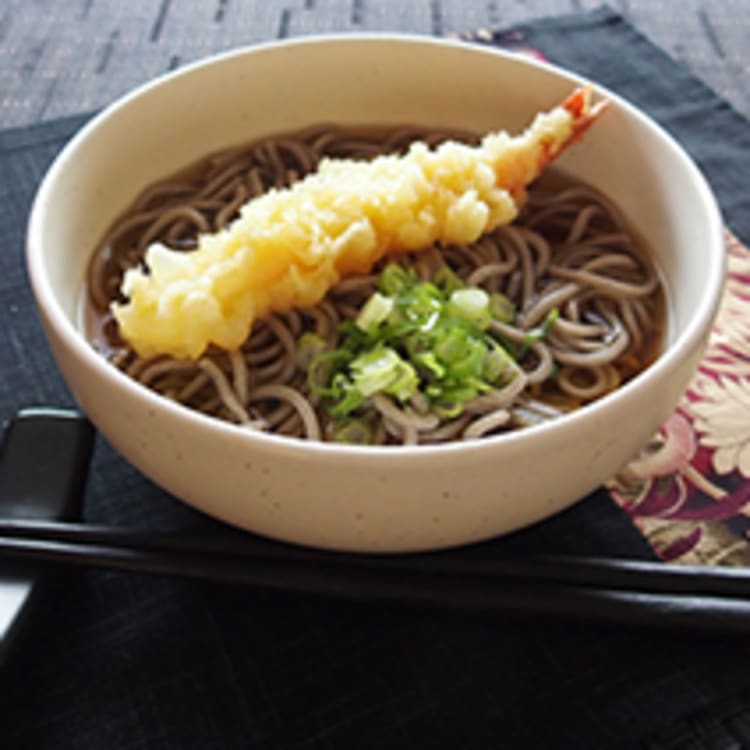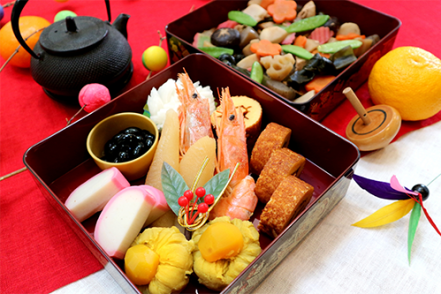
STORY New Year food traditions by JNTO Gourmet on 21 December 2018
New Year in Japan is a major affair, and food plays an important part of the traditions – and have been since the Edo period. These customs include the eating of toshikoshi soba, osechi, and ozoni which are traditionally eaten with the family around the New Year period.
Toshikoshi Soba
Since the Edo era, the Japanese have been eating soba before the new year to symbolise a long life (because of its shape). Since soba is made of buckwheat which can survive severe weather, it also represents strength and resiliency.


The reason for eating it on New Year’s Eve is because soba breaks easily while you eat it, which symbolises breaking off the old year, hence it’s called toshikoshi soba which literally means ‘year-end soba’. As such, plenty of soba restaurants are usually packed during dinnertime. In Tokyo, Jindaiji temple (the second oldest in Tokyo) is not only a popular place for celebrating the New Year, it’s also famous for its historic soba restaurants.
There is no rule to eating soba – you can eat it hot or cold (zaru soba), and have it with various toppings like tempura or abura-age (fried tofu). In some parts of Japan, udon is preferred in places like Kagawa, which is famous for its sanuki udon.
Osechi

Normally eaten at home with the family, osechi is served in a jubako (stacked bento boxes), and contains a number of “lucky” foods – usually simmered – with specific meanings, similar to Chinese New Year’s lo hei. The food is normally eaten within the first three days of the New Year, with special chopsticks that are tapered on both ends; one side for humans, one side for the gods. Depending on the size and extravagance of an osechi, some ingredients include:
Onomatopoeic food names, like:
- Kuromame (black soy beans); the Japanese word for “bean” is “mame”, which sounds like the word for “good health”
- Konbu Maki (dried herring wrapped in seaweed); “konbu” is a play on words, meaning “to be happy”
- Otafuku Mame (large broad bean); “otafuku” (お多福) is written with characters meaning “many fortunes”
- Daidai (orange); “daidai” sounds like the Japanese phrase “generation to generation”, so it’s a wish for couples to have children

Some foods resemble good wishes, like:
- Kazunoko (herring roe) which contains many tiny eggs, symbolising abundant harvest and fertility
- Hoshigaki (dried persimmon) which has skin resembling the wrinkled skin of an old person, so it’s a wish for a long life
- Kuwai (root of the Sagittaria plant) which has a single sprout which symbolises a successful career

Other items represent good omen in Japanese custom, like:
- Kohaku Namasu (red & white vinegar daikon & carrots) and Kohaku Kamaboko (fishcake), both with a red-and-white colour scheme to symbolise good omen (red is a talisman against evil, while white signifies purity)
- Yakizakana (grilled fish) which is normally eaten for a successful career. For example, eating grilled eel is a prayer for a successful promotion
Traditionally made at home, these days busy families normally order pre-made ones from department stores, restaurants, or even convenience stores. You can also order osechi up to a week in advance at convenience stores or department stores (websites are in Japanese only).
Many ryokans and hotels also serve osechi during the first three days of the New Year – like Ryumeikan (website in Japanese only) in Tokyo – by reservation only.
Ozoni

Ozoni is a soup traditionally eaten alongside an osechi meal. The main ingredient is mochi (ricecake); because it's stretchable, it represents longevity. Different regions in Japan have their own style of soup and other ingredients. Some regions close to ocean include fish and seafood, while mountain regions use vegetables and mushrooms. Most ozoni use a clear soup (usually soy sauce based) while the Kansai region uses miso.
For example, in Osaka the mochi is boiled together and ingredients such as grilled tofu, radish and carrots in a white miso-based soup, while in the Kanto region, ozoni contains ingredients like chicken, carrot and leafy vegetables, cooked in a clear soup garnished with yuzu peel. The Niigata version contains a soy sauce-based soup made from fish, with salmon roe and salmon slices, while in Tottori Prefecture the soup is clear, and it contains just red beans and mochi.

























































